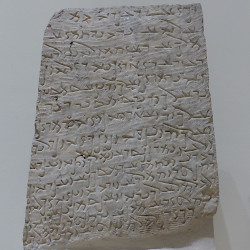Hatra
Q466614Hatra: city in Mesopotamia, buffer state between the Roman Empire and its neighbors in the east, the Parthian and Sasanian Empires.

The name Hatra is Aramaic and probably means something like “enclosure”. It must refer to the temenos of the temple of the sun god Šamaš. The Hatrenes themselves called the city Beit Elaha, “house of god”. There is no evidence for occupation of the site prior to the Parthian age, although several statues appear to date to the Seleucid period.
Situated between the fertile plains of Assyria beyond the Tigris in the east and the valley of the Euphrates in the west, Hatra was an important trade center, comparable to Palmyra and Petra. Trade was often centered on sanctuaries, and the temple of Šamaš must have functioned in ways that were comparable to the sanctuaries along, for example, the Incense Route on the Arabian Peninsula. The inhabitants were a mixture of people: descendants of the ancient Assyrians and Babylonians, Aramaeans from Syria, Greek and Macedonian veterans, Parthian and Persian Iranians, and an Arabian dynasty. In the course of the first century the Hatrenes created a kingdom of their own.
 Hatra, Statue of Shahiro (?), the morning star |
 Hatra, Temple of Šamaš |
 Hatra, Decoration with dromedaries |
 Hatra, Relief of two dromedaries |
Like so many Iranian cities, Hatra was built on a circular plan (cf. Firuzabad). The sacred enclosure and the main sanctuary were in the center. Here, the Babylonian gods Šamaš and Nergal were venerated, together with the Greek god Hermes, the Syrian goddess Atargatis, the Phoenician god Ba'al Šamem ("lord of heavens"), and the Arabian goddess Allat. Archaeologists have focused on the sacred enclosure with its monumental architecture, but the city itself was harder to investigate, except for the outer walls, which had a circumference of about two kilometers, fortified with more than 160 towers. The Romans considered them "tall and strong".note
Although the kingdoms in the east were important buffer states, the Romans increasingly tried to get more control of them: Commagene, Nabataea, Palmyra, Edessa, Nisibis, and Hatra all experienced Roman attempts to seize power. The Hatrenes were exceptional in being able to survive as an independent state, in spite of sieges by the emperors Trajan (116/117) and Septimius Severus (197/198). The Hatrenes were finally forced to surrender to the Sasanian king Shapur, who sacked the city in 241.
The city was looted by the so-called Islamic State in 2015.











